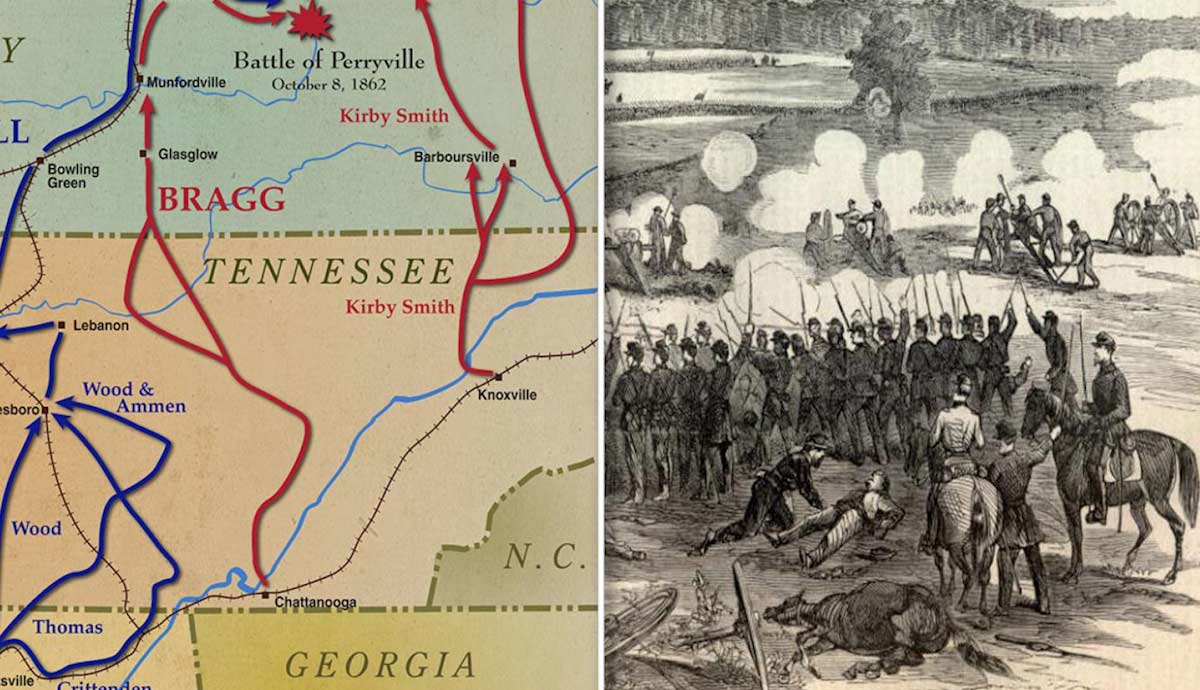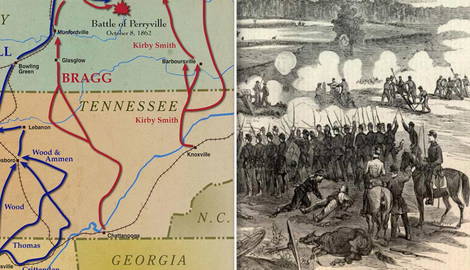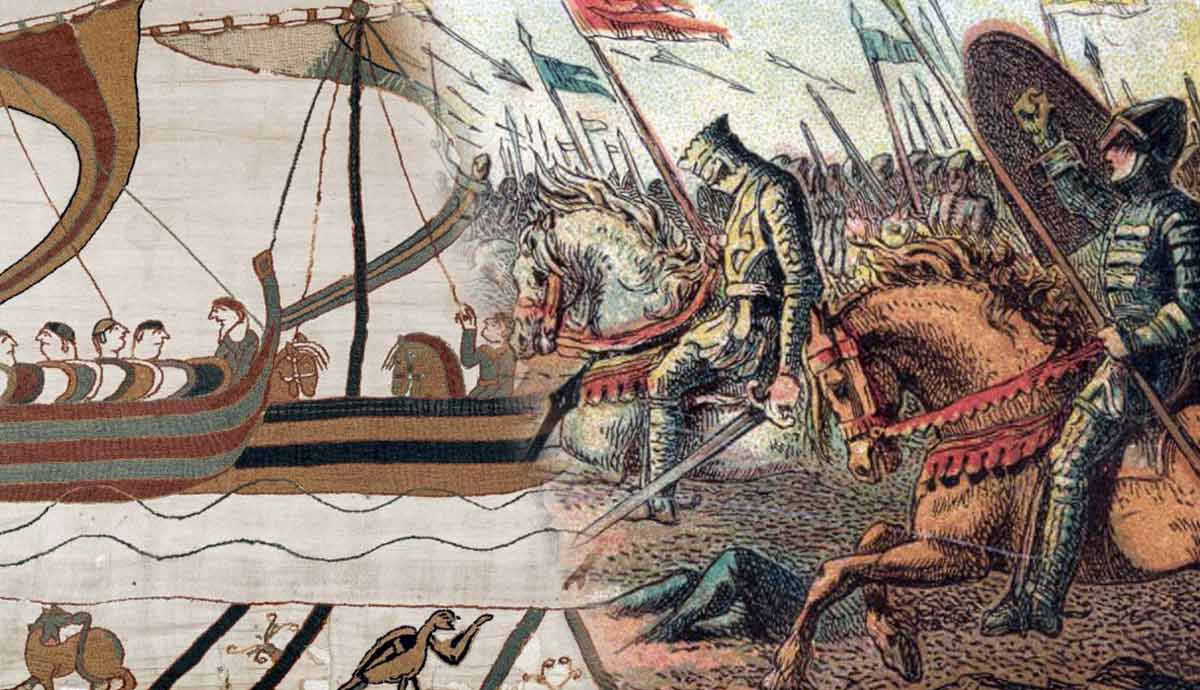
In 1861, both the Union and the Confederacy desired to control the wealthy and geographically well-situated border state of Kentucky. Although the state declared neutrality, the Union and the Confederacy each sent an army to occupy the northern and southern halves of the state, respectively. After defeats in the spring of 1862, the Confederates decided to regroup and mount an offensive, aiming to retake a state that was assumed to be pro-South.
Who Won the Battle of Perryville?

The Confederacy was in a tough position in the early autumn of 1862. Despite managing to hold off the much larger and more industrialized Union in the Eastern Theater between Washington DC and Richmond, Virginia, the Battle of Shiloh in April 1862 had revealed that the Western Theater could not easily be defended. Despite recent losses, the Confederacy felt that going on the offensive in the Western Theater could divert Union troops and buy time. The goal: Kentucky, one of the border states that had pledged neutrality in the Civil War. Southern leaders felt that the state would be a good source of supplies and recruits for its armies.
In what became one of the most intensely fought battles of the war, Confederate General Braxton Bragg ordered his 16,000 troops to attack what turned out to be a larger Union army near the small town of Perryville, Kentucky. Over an afternoon of bloody fighting on October 8, 1862, Bragg’s forces managed to push Union troops back about a mile. For this, Bragg claimed victory. However, Bragg was still outnumbered and had to withdraw from Kentucky, giving the Union an opportunity to claim victory. Although Bragg’s Confederate army won the day on October 8, the Union won a long-term victory by vanquishing the Confederacy from the state of Kentucky for the remainder of the war.
Timeline of the Battle of Perryville

In the summer of 1862, the Confederacy decided to mount an offensive in the Western Theater to turn the tide of war. The immediate goal was to divert Union forces from Tennessee, which had been slowly conquered since the spring. To draw them out and potentially allow the Confederacy to recapture cities in Tennessee, Confederate General Braxton Bragg spent June and July moving his entire field army from Mississippi to Tennessee via railroad–a first in the war–in anticipation.
On July 31, Bragg met with fellow commanders in Chattanooga, Tennessee, and outlined a plan to liberate Kentucky and advance as far north as the Ohio River.
Four weeks later, Bragg finally began his advance into Kentucky, timed to coincide with Robert E. Lee’s invasion of Maryland.
Quickly, Bragg’s plan faltered as the desired Kentuckian recruits did not materialize. After spending a week away from his army on diplomatic business, including inaugurating a Confederate governor in the city of Frankfort, Bragg returned to find that the Union army was rapidly approaching.
Union general Don Carlos Buell arrived at Perryville on October 7, planning to attack the next morning. However, his troops were tired, so Buell planned to give them time to rest.
Bragg seized the initiative and attacked at midday on October 8, 1862. Intense Confederate attacks on the Union flanks led them to withdraw to better defensive positions by late afternoon. The Union center fared better, but was cautious and did not wish to fight the Confederates in the town of Perryville, and so did not attack. By dusk, the battle was over, with the Union forces having withdrawn.
What Caused the Battle of Perryville?

The defeat at Shiloh and the loss of New Orleans in April 1862 were twin devastations to the South. Confederate President Jefferson Davis wanted an offensive to regain the initiative in the war, and so replaced General P.G.T. Beauregard with the more aggressive Braxton Bragg as commander of the Army of Mississippi. An invasion of Kentucky was believed to be the ideal goal of the Confederate Heartland Offensive, as the state had bountiful supplies and many young men who–it was thought–would eagerly enlist in the Confederate military. A military victory in Kentucky would also frighten the North and possibly lead to peace talks, allowing for an independent Confederate States of America.
The Union swiftly responded to Braxton Bragg’s invasion of Kentucky by sending General Don Carlos Buell away from Chattanooga, Tennessee to intercept. The Union and Confederate armies slowly converged, and on October 8, they encountered each other while both desperately searching for water. Unable to find separate water sources, the two armies were essentially forced into combat. Originally, neither side planned to attack on October 8; Bragg forced the issue when he discovered that his colleague, General Edmund Kirby Smith, had not attacked yet.
Why Was the Battle of Perryville Significant?

The Battle of Perryville is sometimes called the “high water mark” of the Confederacy in the Western Theater, similar to how the Battle of Gettysburg receives that nickname for the entire conflict. Although the battle itself came long after the September 1862 invasion of Kentucky, the invasion of Kentucky as part of the Confederate Heartland Offensive could be seen as the high watermark of the Confederacy in conjunction with its simultaneous invasion of Maryland. For perhaps the only time, the Confederacy was committing a major offensive on both fronts of the war (though, ultimately, neither were successful).
After the battle, the Confederate loss in Kentucky was significant in that it represented full control over the border states by the Union. Additional significance comes from the intensity of the fighting, with very high casualties relative to the number of forces committed. The Confederate Heartland Offensive was the last major Confederate offensive campaign in the Western Theater, with the Confederacy operating defensively after October 1862. Additionally, the indeterminate outcome of the Battle of Perryville would haunt both commanding officers.
What Were the Casualties?

Casualties during the Battle of Perryville totaled just over 7,500, with the Union forces suffering about 800 more casualties than the Confederates. Each side suffered about 2,600 wounded men, with the Union having somewhat higher numbers of missing, captured, and killed soldiers than their enemy. Confirmed soldiers killed were over 800 for the Union and about 500 for the Confederacy for the one-day battle.
Who Were the Commanders?
Union forces were led by General Don Carlos Buell, a rather conservative northerner. Like most Civil War generals, Buell was a West Point graduate–class of 1841–and veteran of the Mexican-American War, where he was wounded in battle. Prior to the Civil War, Buell served in both Texas and California, as well as in the Seminole Wars in Florida. Career-wise, Buell’s own high-water mark came from participating in the Union victory at Shiloh.
Confederate forces were led by General Braxton Bragg, who graduated from West Point four years before Buell. Like Buell, Bragg served in both the Seminole Wars and the Mexican-American War before leaving the army on December 31, 1855. Ironically, Bragg left the army after a dispute with then-Secretary of War Jefferson Davis, who would later become president of the Confederacy. During the Civil War, Davis befriended and assisted Bragg up through the Battle of Chickamauga, where Bragg won a costly victory over Union General William Rosecrans.
What Was the Number of the Forces Involved?

Union forces under Don Carlos Buell numbered 55,000, though far fewer were actually committed to battle, partially due to error by Buell. By contrast, Bragg had a much smaller force of only 16,000 men. Bragg insisted on attacking on October 8 because he believed that only a portion of Buell’s army was present, which was also in error. Buell’s failure to commit more of his forces led to what could be considered a Confederate victory on the battlefield.
Visiting Perryville, Kentucky Today
Today, visitors can visit the Perryville Battlefield State Historic Site, which is part of Kentucky State Parks. The state park, dedicated in 1936, covers some 1,200 acres and is near the town of Perryville. There are 19 miles of hiking trails, and the battlefield is often praised as one of the most well-preserved from the Civil War. Although not a national park, the National Park Service awarded a grant to help preserve the battlefield in 2019.
Trivia: Civilians Encounter the War
In a relative rarity, the citizens of the town of Perryville, Kentucky had close encounters with the battle. Soldiers camped out on private property and even used houses and barns for shelter. Civilians helped gather the dead and wounded, and some returned home to find hundreds of dead soldiers on their land. According to lore, a one-armed soldier returned to one of several homes used as a battlefield hospital years after the war and, with the permission of the family, dug up his missing arm and took it home.
Aftermath of Perryville: Bragg & Buell Both Berated

The failure of Union general Don Carlos Buell to pursue a retreating Braxton Bragg after the Battle of Perryville ended up ruining the former’s career. On October 24, 1862, less than three weeks after the battle, Buell was relieved of his command and replaced with General William Rosecrans. Also in a relative rarity for the war, Buell was not given a reassignment to a lesser post but was outright mustered out of the US Army in May 1864 after refusing to serve under lower-ranked generals. He lived for more than 30 years after the war, dying in 1898 in Kentucky.
Braxton Bragg, who personally frustrated many of his colleagues and subordinates with an abrasive character, was also criticized after Perryville. However, Confederate President Jefferson Davis supported Bragg and kept him at his post. Thirteen months later, however, Bragg’s loss at Chattanooga, Tennessee signaled his end as an active general. Bragg spent the remainder of the war as an adviser to Jefferson Davis and fled the Confederate capital city of Richmond with Davis before being captured on May 9, 1865. After moving to Texas, Bragg died in Galveston in 1876.










